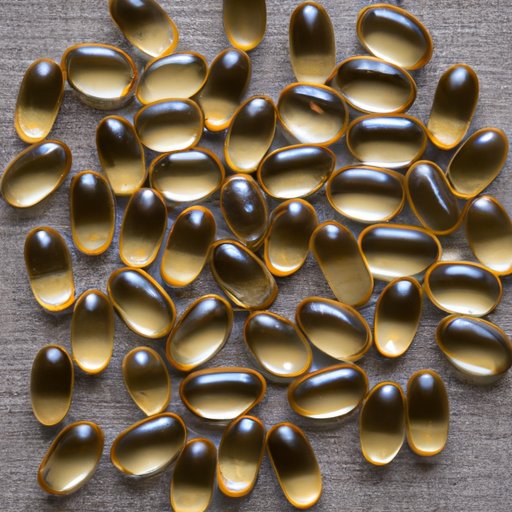
I. Introduction
Vitamin E is a group of fat-soluble compounds that play a vital role in maintaining our overall health. Its powerful antioxidant properties protect our cells from damage, boost our immune system, and improve our skin health and appearance. In this article, we will delve into the origins of vitamin E and its natural sources, highlighting its benefits and emphasizing why it is essential to consume from natural sources.
II. Exploring the Natural Sources of Vitamin E
Nature has blessed us with a plethora of choices to obtain vitamin E. Here are two of the best sources:
A. Sunflower Seeds
Sunflower seeds are an excellent source of vitamin E. In fact, a small handful of sunflower seeds provides about 37% of our daily recommended intake of vitamin E.
In addition to their high vitamin E content, sunflower seeds are packed with other essential nutrients, including protein, healthy fats, and minerals such as magnesium, copper, and selenium. They also have anti-inflammatory properties that reduce the risk of chronic conditions like heart disease, diabetes, and cancer.
You can easily incorporate sunflower seeds into your diet by sprinkling them over salads, oatmeal, or mixing them in with yogurt or smoothies. You can also enjoy them roasted as a crunchy snack.
B. Spinach
Spinach is another nutrient-rich food packed with vitamin E. Just one cup of cooked spinach contains more than 20% of our daily recommended intake of vitamin E.
Spinach is also high in iron, which is essential for healthy blood function. It is also an excellent source of vitamins A, C, and K, as well as folate and calcium. Spinach has anti-inflammatory properties that help regulate our immune system and reduce the risk of chronic disease.
You can incorporate spinach into your diet by adding it to salads, sandwiches, omelets, or smoothies. You can also sauté it as a delicious side dish or add it to soups and stews.
III. Unveiling the Mystery Behind Vitamin E Origins
Vitamin E occurs naturally in many foods, mainly in plant-based sources such as nuts, seeds, and leafy greens. Consuming vitamin E from these natural sources is essential as it contains other beneficial nutrients that work together in our bodies and are better absorbed than synthetic supplements.
The agricultural process of growing and sourcing vitamin E is crucial. Vitamin E is produced by various plants such as sunflowers, wheat germ, and nuts like almonds, pecans, or hazelnuts.
IV. Everything You Need to know About the Origin of Vitamin E
A. Types of Vitamin E Naturally Occurring
The most commonly known types of vitamin E are tocopherols and tocotrienols. Both are structurally different, and each has several subtypes. Alpha-tocopherol is the most easily absorbed by our bodies and the most commonly used in supplements.
B. Chemical Makeup of Vitamin E
Vitamin E is a fat-soluble compound made up of eight different compounds split into two groups, tocopherols and tocotrienols. Each compound has different antioxidant properties that work together to protect our cells from damage.
C. Health Benefits of Consuming Vitamin E from Natural Resources
Research shows that vitamin E has several health benefits, including:
- reducing oxidative stress and inflammation
- improving cardiovascular health
- boosting our immune system
- improving skin health and appearance
- reducing the risk of chronic diseases such as Alzheimer’s, Parkinson’s, diabetes, and cancer.
V. From the Soil to Your Supplement: How Vitamin E is Sourced and Processed
Vitamin E is processed and sourced from plants such as wheat germ, sunflower seeds, almonds, and hazelnuts. Most vitamin E supplements on the market are synthetic and produced by isolating alpha-tocopherol.
The process of manufacturing supplements varies, but it generally involves using high heat, pressure, and chemicals to extract the vitamin E. Synthetic supplements are not absorbed as well in our bodies as natural sources.
When choosing supplements, make sure to opt for those that contain a mix of tocopherols and tocotrienols, and ensure that they are sourced from natural sources.
VI. The Journey of Vitamin E in Nature
Vitamin E is not only essential to our overall health, but its benefits are recognized worldwide. Different cultures and continents have diverse sources of vitamin E, contributing to the diversity of its sources.
In West Africa, red palm oil, which contains high levels of vitamin E, is used in cooking and traditional medicine. In Japan, a popular ingredient in many dishes is wakame, a type of seaweed with high levels of vitamin E.
To benefit from this diversity, we can incorporate different sources of vitamin E into our diets, such as red palm oil, wakame, and other diverse sources from different parts of the world.
VII. Nature’s Bounty: Where to Find the Best Sources of Vitamin E for Optimum Health
If you want to consume vitamin E from natural sources, here are some excellent options:
- Sunflower seeds and oil
- Wheat germ oil
- Almonds
- Hazelnuts
- Spinach
- Avocado
- Red palm oil
- Tomatoes
- Kiwi
- Mangoes
- Turnip Greens
It is important to note that the vitamin E content in food can vary depending on its source, processing, and storage. When sourcing vitamin E, opt for whole foods and try to buy locally sourced, organic produce whenever possible.
VIII. Conclusion
Vitamin E is a vital nutrient for our overall health and well-being. Consuming vitamin E from nature’s bounty increases the benefits and provides other essential nutrients to work together in our bodies. Choose sources of vitamin E such as sunflower seeds, spinach, wheat germ oil, and almonds, and avoid synthetic supplements. Incorporate different sources of vitamin E from diverse cultures around the world and opt for locally sourced whole foods to enjoy maximal benefits from this precious nutrient.
Let us commit to living a healthy lifestyle today by incorporating vitamin E from natural sources into our daily diets to strive towards a healthier tomorrow.





